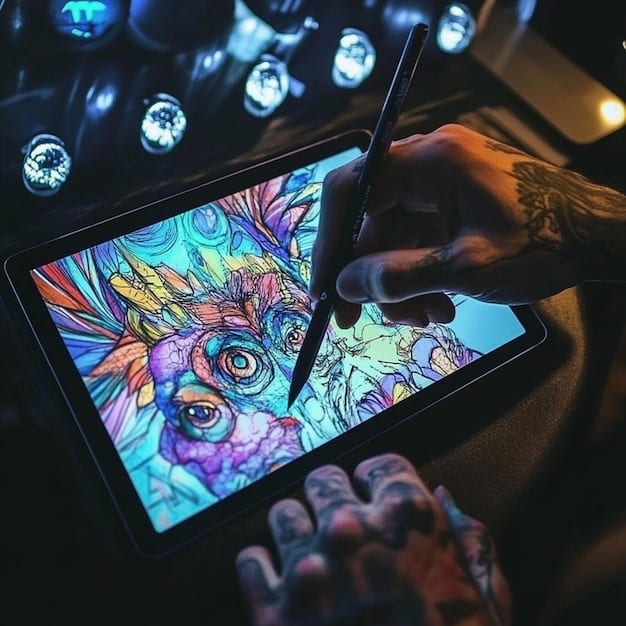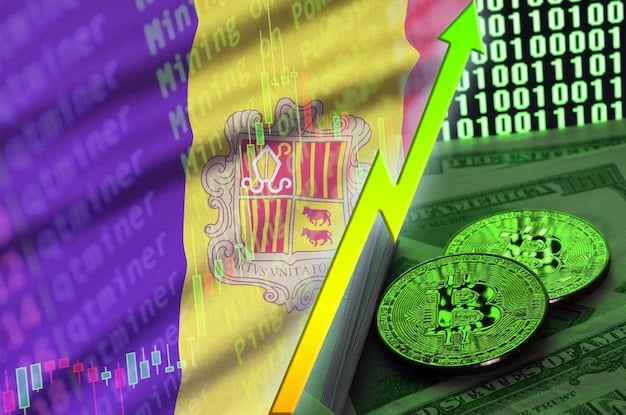NFTs for US Artists: Your Guide to Selling Art Online

NFTs for US artists provide a revolutionary way to sell digital artwork directly to collectors, offering new revenue streams and creative control. This guide explores the process, from minting to marketing, empowering artists to navigate the NFT landscape.
The world of digital art is evolving, and NFTs for US artists are at the forefront, revolutionizing how art is bought, sold, and owned. For artists, this opens exciting new opportunities to connect with collectors directly, bypass traditional gatekeepers, and potentially earn more from their creations. Ready to dive in?
Understanding NFTs and Their Value for US Artists
NFTs, or Non-Fungible Tokens, may seem complex, but they are essentially unique digital assets. For US artists, understanding NFTs is crucial to unlock new avenues for selling and showcasing their work.
NFTs are revolutionizing the art world by providing a way to authenticate and trade digital artwork in a secure and transparent manner.
What Makes an NFT Unique?
An NFT’s uniqueness stems from its distinct metadata and blockchain technology. This ensures each token is verifiably original and cannot be replicated.
The Benefits for US Artists
US artists can benefit from NFTs in several ways, including:
- Directly connecting with collectors worldwide.
- Setting their own prices and royalties.
- Gaining more control over their artistic creations.

Understanding the underlying technology and potential benefits can empower US artists to take control of their careers and reach a wider audience with their creations.
Setting Up Your Digital Wallet and Choosing a Marketplace
To participate in the NFT space, US artists will need a digital wallet and a marketplace to sell their artwork. These are key steps in the process of embracing NFTs.
Choosing the right tools and platforms is essential for a smooth and successful NFT experience.
Choosing a Digital Wallet
Digital wallets are used to store, send, and receive cryptocurrencies and NFTs. Here are a few popular options:
- MetaMask: A widely used browser extension and mobile app.
- Coinbase Wallet: A user-friendly wallet from a popular exchange.
- Trust Wallet: A secure mobile wallet supporting multiple blockchains.
Selecting an NFT Marketplace
NFT marketplaces are platforms where you can list and sell your digital art. Consider these factors when choosing a marketplace:
- Fees: Marketplace fees can vary, affecting your earnings.
- Audience: Some marketplaces cater to specific art styles or communities.
- Ease of Use: Opt for a platform with an intuitive interface.
Setting up your digital wallet and selecting the right marketplace will lay the foundation for your NFT journey. It is crucial to research and select options that align with your artistic goals and technical comfort.
Minting Your Art: Creating Your First NFT
The process of turning your digital artwork into an NFT is called “minting.” It involves uploading your artwork to the blockchain and creating a token that represents it.
Minting is a crucial step in making your art tradable on the NFT market.
Preparing Your Artwork
Before minting, ensure your artwork is in the correct format (e.g., JPG, PNG, GIF) and resolution. Consider adding metadata, such as the title, description, and creation date.
The Minting Process
Here’s a simplified overview of how to mint your NFT:
- Connect your digital wallet to the chosen marketplace.
- Upload your artwork file.
- Fill in the NFT details, including title, description, and royalties.
- Pay the minting fee (often called “gas fee”).
- Confirm the transaction on the blockchain.
Always research the gas fees associated with minting, as they can fluctuate depending on network congestion.
Pricing Strategies and Royalties for US Artists
Pricing your NFTs correctly and defining royalties are essential for generating revenue and ensuring long-term benefits as a US artist.
Strategic pricing and royalty settings are crucial for a sustainable NFT business model.
Setting Your Initial Price
Consider the following when determining the initial price of your NFTs:
- Rarity: How unique or limited is the artwork?
- Production Cost: Consider the time and resources invested in creating the artwork.
- Market Demand: Research similar artworks and their prices.
Understanding Royalties
Royalties allow you to earn a percentage of future sales of your NFT. Setting appropriate royalties can provide a passive income stream. Common royalty rates range from 5% to 10%.

Pricing your NFTs should be a careful balance between attracting buyers and fairly valuing your work. Don’t underestimate the power of royalties in your long-term financial strategy.
Marketing Your NFTs to a US Audience
Promoting your NFTs is crucial to reaching potential buyers and building a loyal audience. Effective marketing can increase visibility and drive sales.
Marketing is key to standing out in the crowded NFT marketplace.
Leveraging Social Media
Use platforms like Twitter, Instagram, and Discord to showcase your artwork, engage with your audience, and announce new NFT drops. Share behind-the-scenes content to build a connection with your followers.
Collaborating with Other Artists
Collaborating with other artists can cross-promote your work and reach new audiences. Consider joint NFT projects or cross-promotion campaigns.
Engaging with the NFT Community
Participate in NFT communities, attend virtual events, and engage in discussions. Building relationships within the community can help you gain visibility and credibility.
Effective marketing strategies, including social media engagement, collaborations, and community involvement, can significantly increase the reach and value of your NFTs.
Legal and Tax Considerations for US NFT Artists
Understanding the legal and tax implications of selling NFTs is crucial for US artists. Compliance with regulations can protect your interests and prevent legal issues.
Navigating the legal and tax landscape is essential for a sustainable NFT practice.
Intellectual Property Rights
Ensure you have the rights to the artwork you’re minting as an NFT. If you’re using copyrighted material, obtain the necessary permissions or licenses.
Tax Implications
NFT sales are generally subject to income tax and may be subject to capital gains tax, depending on how long you held the NFT before selling it. Consult with a tax professional to understand your obligations.
Terms and Conditions
Pay attention to the terms and conditions of the NFT marketplaces you use. Understand your rights and responsibilities as a seller.
Consulting with legal and tax professionals can ensure the sustainability and security of your NFT endeavors.
| Key Point | Brief Description |
|---|---|
| 🔑 Understanding NFTs | Unique digital assets representing your artwork. |
| 💰 Pricing & Royalties | Set prices based on rarity and market demand; define royalty rates. |
| 📢 Marketing Strategies | Use social media, collaborate, and engage to promote your NFTs. |
| 🛡️ Legal & Tax | Understand intellectual property, tax obligations, and marketplace terms. |
FAQ
▼
An NFT (Non-Fungible Token) is a unique digital asset, like a certificate of authenticity, that proves ownership of a digital item, such as artwork or music, using blockchain technology. It makes the asset verifiable and tradable.
▼
Gas fees are transaction fees required to perform actions on a blockchain, such as minting or selling an NFT. These fees fluctuate based on the network’s activity and can impact the cost of participating in the NFT market.
▼
Consider factors like fees, audience, supported blockchains, and ease of use. Some marketplaces specialize in particular types of art or cater to specific communities, so choosing one that aligns with your art style is beneficial.
▼
A common royalty range is 5% to 10%. Setting a royalty ensures you earn a percentage of future sales of your NFT, providing a passive income stream. Balance attractiveness to initial buyers with long-term earnings potential.
▼
NFT sales are generally subject to income tax and may be subject to capital gains tax, depending on how long you held the NFT before selling it. Consult with a tax professional for personalized advice on your specific situation.
Conclusion
Navigating the world of NFTs for US artists can seem daunting, but with the right knowledge and strategies, it presents a significant opportunity to connect with collectors, control your artistic output, and build a sustainable business. By understanding the technology, setting up your digital infrastructure, and engaging with the community, you can unlock the potential of NFTs and revolutionize your artistic career.





